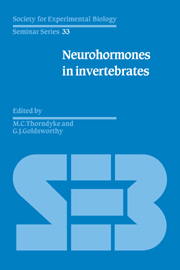Book contents
- Frontmatter
- Contents
- List of contributors
- Preface
- What is special about peptides as neuronal messengers?
- Part I Immunocytochemistry and Ultrastructure
- Part II Arthropod Neurohormones
- Characterization of insect neuropeptides
- The isolation and characterisation of vertebrate-type peptides in insects
- Humoral functions of insect neuropeptides
- Functions of aminergic and peptidergic skeletal motoneurones in insects
- Physiology and biochemistry of crustacean neurohormonal peptides
- Part III Neurohormones in Coelenterates, Annelids and Protochordates
- Part IV Neurohormones in Molluscs
- Index
Physiology and biochemistry of crustacean neurohormonal peptides
Published online by Cambridge University Press: 04 August 2010
- Frontmatter
- Contents
- List of contributors
- Preface
- What is special about peptides as neuronal messengers?
- Part I Immunocytochemistry and Ultrastructure
- Part II Arthropod Neurohormones
- Characterization of insect neuropeptides
- The isolation and characterisation of vertebrate-type peptides in insects
- Humoral functions of insect neuropeptides
- Functions of aminergic and peptidergic skeletal motoneurones in insects
- Physiology and biochemistry of crustacean neurohormonal peptides
- Part III Neurohormones in Coelenterates, Annelids and Protochordates
- Part IV Neurohormones in Molluscs
- Index
Summary
Introduction
A seemingly bewildering array of factors with putative neurohormonal function have been described in (mainly decapod) Crustacea (see Kleinholz & Keller 1979; Cooke & Sullivan 1982; Keller 1983; Kleinholz 1985). They are implicated in almost every aspect of crustacean physiology, including pigment dispersion and concentration, inhibition of moulting, limb regeneration and gonad development, cardiac control, blood glucose, metabolism and respiratory control, ion and water balance, endogenous rhythmicity and locomotion. Several of these factors are produced by neurosecretory structures in the eyestalk, which can be easily ablated. This accessibility has unfortunately led to a tendency to assign hormonal regulation of physiological mechanisms based solely upon the results of eyestalk removal, often without the rigorous application of deficiency and replacement protocols using physiologically relevant doses of extracts or further purification of the active principle. Thus, apart from the well known neuropeptides, it is not known how many of these described ‘factors’ genuinely control individual processes and little is known of their precise chemical identity.
Evidence from immunocytochemical studies suggests that many neuropeptides classically known as ‘vertebrate’ peptides and also neuropeptides that have originally been found in invertebrates (e.g. FMRF amide, proctolin) are ubiquitous in crustaceans (Mancillas et al. 1981; Jacobs & Van Herp 1984; Jaros et al. 1985; Van Deijnen et al. 1985; Stangier et al. 1986). However, there is at present little information concerning the role of ‘vertebrate-type’ peptides in physiological integration.
- Type
- Chapter
- Information
- Neurohormones in Invertebrates , pp. 173 - 196Publisher: Cambridge University PressPrint publication year: 1988
- 10
- Cited by



